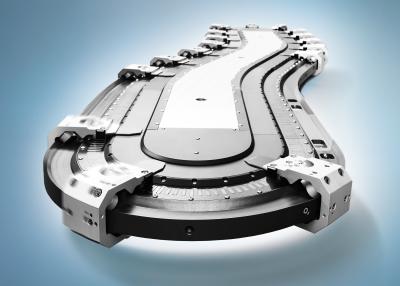
The eXtended Transport System (XTS) from Beckhoff Automation is now available in the U.S. The EtherCAT-enabled XTS offers paradigm-shifting capabilities for motion control and mechatronics by combining the advantages of proven rotary and linear drive principles into a new modular platform. With its compact and flexible design, the advanced mechatronic system can reduce machine footprint up to 50%. The XTS revolutionizes drive technology and promotes innovative, globally competitive machine concepts.
XTS contains all functions necessary to support efficient integration for motion control applications in many industries. With attached mechanical guide rails, XTS motor modules feature directly integrated power electronics, EtherCAT communication and position measurement. An unlimited number of wireless XTS movers can be controlled with high dynamics at up to 4 m/s on extremely customizable paths. By harnessing the flexibility and scalability of EtherCAT, PC-based control and TwinCAT 3 automation software from Beckhoff, XTS enables flexible mass production down to lot size 1 for the smart factories of today.
“Through the capabilities of XTS, Beckhoff once again empowers engineers and machine builders to take leading-edge machine designs to the next step,” said Kevin Barker, president of Beckhoff Automation LLC. “The launch of XTS in the United States will provide significant opportunities for customers in numerous industries to boost throughput, shrink machine footprint and increase flexibility while eliminating time-consuming mechanical changeovers. This mechatronic system will be a key innovation driver for all companies that use it.”
The application possibilities of XTS are virtually limitless: Movers can accelerate, brake, position and synchronize themselves on the fly with automatic collision avoidance provided by TwinCAT 3 software. They can take up absolute positions and positions relative to each other; they can group themselves and accumulate; they can create clamping forces in motion, drive through curves and along straights, recover energy through regenerative braking and use both the return and outward paths for transport purposes.
This linear motor principle unlocks new possibilities in drive technology:
- linear motor characteristics with unlimited movers on an endless path
- low machine footprint and power requirements
- simple implementation of complex handling and transport tasks
- low project engineering and assembly expenditure
Simple XTS motor modules form a complete unit with the movers and guide rails. The desired geometries, lengths and radii are determined by the number and type of the components selected, with various options for 22.5-, 45- and 180-degree modules to enable circle, clothoid and S-curve designs as well as open straight segments. Motor modules contain electromagnetic coils and all other active functions necessary for operation. The only further requirements are a power supply and EtherCAT connection. Motor modules contain no moving parts and are thus not susceptible to wear.
The XTS movers contain magnetic plates that, together with the coils in the motor modules, generate propulsive forces. Movers absorb the attractive forces of the magnets on both sides and compensate for them. As a result, the rollers, composed of particularly low-wear plastic, can move at high speeds with acceleration greater than 100 m/s2. A mechanically robust encoder flag communicates mover position to the motor modules.
XTS presents unlimited possibilities for applications across diverse industries. However, the system is particularly well-suited to high-speed material handling:
- optimize irregular product flows to constant intervals and speeds
- clamp and move products
- pick up, transport and discharge products
- manipulate products: lift out, close, rotate, screw on caps
- process products one at a time or in parallel in groups
- integrate with robotics in real-time via EtherCAT
Contact Details
Related Glossary Terms
- linear motor
linear motor
Functionally the same as a rotary motor in a machine tool, a linear motor can be thought of as a standard permanent-magnet, rotary-style motor slit axially to the center and then peeled back and laid flat. The major advantage of using a linear motor to drive the axis motion is that it eliminates the inefficiency and mechanical variance caused by the ballscrew assembly system used in most CNC machines.
- parallel
parallel
Strip or block of precision-ground stock used to elevate a workpiece, while keeping it parallel to the worktable, to prevent cutter/table contact.
- robotics
robotics
Discipline involving self-actuating and self-operating devices. Robots frequently imitate human capabilities, including the ability to manipulate physical objects while evaluating and reacting appropriately to various stimuli. See industrial robot; robot.
